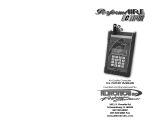
190-00870-02 Rev. A
Garmin G950 Pilot’s Guide for the Pilatus PC-6
vii
TABLE OF CONTENTS
Passenger Address (PA) System .................................. 127
Clearance Recorder and Player ................................... 127
Split COM Operation ................................................. 128
Entertainment Inputs ................................................ 129
Multifunction Controls .............................................. 130
4.6 Audio Panel Preflight Procedure ....................... 131
4.7 Abnormal Operation ........................................... 132
Stuck Microphone ..................................................... 132
COM Tuning Failure ................................................... 132
Audio Panel Fail-safe Operation ................................. 132
PFD Failure (Reversionary Mode) ............................... 132
SECTION 5 FLIGHT MANAGEMENT
5.1 Introduction ......................................................... 133
Navigation Status Box ............................................... 134
5.2 Using Map Displays ............................................. 136
Map Orientation ....................................................... 136
Map Range .............................................................. 138
Map Panning ............................................................ 140
Measuring Bearing and Distance ................................ 145
Topography .............................................................. 146
Map Symbols ........................................................... 149
Airways ................................................................... 155
Track Vector ............................................................. 157
Wind Vector ............................................................. 158
Nav Range Ring........................................................ 159
Fuel Range Ring ....................................................... 160
Field of View (SVT) .................................................... 161
Selected Altitude Intercept Arc ................................... 162
5.3 Waypoints ............................................................. 163
Airports ................................................................... 164
Intersections ............................................................ 171
NDBs ....................................................................... 173
VORs ....................................................................... 175
User Waypoints ........................................................ 177
5.4 Airspaces .............................................................. 183
5.5 Direct-to-Navigation .......................................... 187
5.6 Flight Planning ..................................................... 192
Flight Plan Creation .................................................. 193
Adding Waypoints to an Existing Flight Plan ................ 198
Adding Airways to a Flight Plan ................................. 200
Adding Procedures to a Stored Flight Plan .................. 203
Flight Plan Storage ................................................... 210
Flight Plan Editing .................................................... 212
Along Track Offsets ................................................... 215
Parallel Track ............................................................ 217
Activating a Flight Plan Leg ....................................... 220
Inverting a Flight Plan ............................................... 221
Flight Plan Views ...................................................... 222
Closest Point of FPL .................................................. 224
User-Defined Holding Patterns ................................... 224
5.7 Vertical Navigation ............................................. 229
Altitude Constraints .................................................. 231
5.8 Procedures ...........................................................235
Departures ............................................................... 236
Arrivals ................................................................... 239
Approaches ............................................................. 242
5.9 Trip Planning ........................................................ 250
Trip Planning ............................................................ 250
5.10 RAIM Prediction................................................... 254
5.11 Navigating a Flight Plan ..................................... 258
5.12 Abnormal Operation ........................................... 286
SECTION 6 HAZARD AVOIDANCE
6.1 Airborne Color Weather Radar .......................... 290
System Description ................................................... 290
Principles of Pulsed Airborne Weather Radar ............... 290
Safe Operating Distance ............................................ 294
Basic Antenna Tilt Setup ............................................ 295
Weather Mapping and Interpretation ......................... 296
Ground Mapping and Interpretation ........................... 306
Weather Radar Overlay on the Navigation Map Page ... 307
System Status ........................................................... 309
6.2 Stormscope Lightning ......................................... 311
Setting Up Stormscope on the Navigation Map ........... 311
Selecting the Stormscope Page .................................. 315
6.3 Terrain Proximity ................................................. 316
Displaying Terrain Proximity Data ............................... 316
6.4 Profile View Terrain ............................................. 321
Profile View Display .................................................. 321
6.5 Terrain-SVS ........................................................... 324
Displaying Terrain-SVS Data ....................................... 325
Terrain-SVS Page ...................................................... 327
Terrain-SVS Alerts ..................................................... 329






















